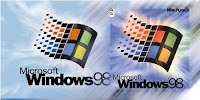
The given information applies to preparing an empty hard disk for the installation of Windows 98. If you use the following steps on a hard disk that is not empty, all of the data that is on that hard disk is deleted.
Before you install Windows 98 on an empty hard disk, you must first create a primary partition and then format a file system on that partition. Each allocated space on the hard disk (primary partition or logical drive) is assigned a drive letter. Windows 98 supports the FAT16 and FAT32 file systems. When you run the Fdisk tool on a hard disk that is larger than 512 MB, you are prompted to choose a file system.
The FAT16 file system has a maximum of 2 gigabytes (GB) for each allocated space, or drive letter. For example, if you use the FAT16 file system and you have a 6-GB hard disk, you can have three drive letters (C, D, and E), each with 2 GB of allocated space.
The FAT32 file system supports drives up to 2 terabytes in size and stores files on smaller sections of the hard disk than does the FAT16 file system. This results in more free space on the hard disk. The FAT32 file system does not support drives that are smaller than 512 MB.
There are two ways to install Windows 98 on your hard disk:
> Copy all of the files from the win98 directory on the Windows 98 CD to a directory on your hard disk and install from your hard disk
> Install directly from the CD.
I prefer the first method for installing Windows 98 on my own hard disk drive. I use the second method when installing Windows on a customer's hard disk. The first method installs faster and every time Windows needs new software or driver from the Windows 98 CD, it will first go to the directory on the hard disk from which it was installed and install the software from there instead asking that you insert the CD. This saves me from having fish-out the Windows 98 CD every time I install new software and hardware, which is often. The advantage of the second procedure is that it saves about 120 MBytes of hard disk space, if in the first method; you leave the files on the hard disk after installation. Furthermore, with the first method, you may still need the CD for some drivers not found in the win98 directory.
Ok, let's install Windows 98:
Method 1
Make a c:\windows\options\cabs directory and copy the files from the win98 directory on the CD-ROM to the cabs directory.
a:\> c:
c:>md windows
c:>cd windows (or simply type cd followed by the F3 key)
c:\windows>md options
c:\windows>cd options
c:\windows\options>md cabs
c:\windows\options>cd cabs
c:\windows\options\cabs>copy d:\win98\*.*
Where d: is your CD-ROM drive.
The c:/windows/options/cabs directory was a convention established with the standard installation some of the OEM (Original Equipment Manufacturer) versions of Windows 95. You could copy the win98 directory to any desired directory on your hard disk and install from there, but I continue to use the convention so I can remember where the cab files are located.
Cab or cabinet files are files containing one or more compressed files. Most of the Windows 98 files are in cab files on the CD.
Install Windows 98.
c:\windows\options\cabs>setup /ie
The /ie flag tells Windows 98 not to make a new Startup Floppy during the installation.
Method 2
Change to the win98 directory on the Windows 98 CD and run setup.exe.
a:\> d:
where d: is your CD-ROM drive letter.
d:\> cd win98
d:\win98 > setup /ie
Do not run setup from d:\. There is a setup.exe there, but it won't work with this procedure.
Just follow the Windows 98 installation prompts. If setup asks you for a directory in which to install Windows, make sure you tell it to install it in c:\windows (not d:\windows or c:\windows.001, etc.).
If you have moved Windows 3.x to the new drive or if you have the old drive attached with Windows 3.x or 95 on it, the upgrade should install ok. If not, setup will say it can't find an old version of Windows to verify before installing the upgrade. It will then allow you to browse to a drive/directory where the old version of Windows is located. If you have Windows 3.x or 95 on floppy, remove your Startup Floppy, if it is still in A:, insert floppy 1 of the old version of Windows in the floppy drive and point setup to the floppy drive. If you have the old version on CD, remove the Win 98 CD, insert the old Windows CD, and point setup to d:\, where d: is your CD-ROM drive. I have found that setup won't always find what it is looking for the first time you point it at the drive containing the old version of Windows. Point again; you may have to do it several times, but it should eventually take. When verifying Win 3.x floppies, setup will check several of them.
Related:
No comments :
Post a Comment
Comment on this Post!!